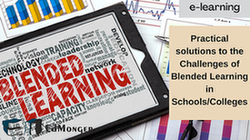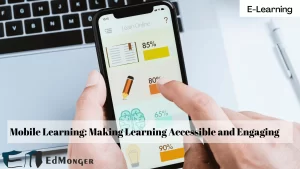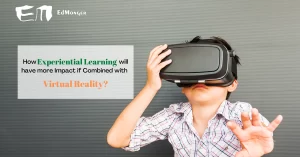Everyone can see the development of educational technology over the past few years. We will witness so many innovations that probably couldn’t have been envisioned until a decade ago, whether online learning, classroom learning, or in any part of the world, a student has to learn anything. In blended learning, where the student can sharpen his skills through both online or offline mediums, other such tools have come into the market, which makes the student’s learning more accessible.
It would help if you were relieved to know that using technological aids will simplify Blended Learning. Yet, you must realize that it is not a simple task. Some obstacles or challenges must be overcome before it can be successfully implemented in the classroom or university.
This article will reveal information about these blended learning challenges and ways to overcome them so those considering implementing a Blended Learning curriculum at your school or university can be prepared well in advance.
Challenges And Solutions Of Blended Learning In School/College
Fail To Evaluate The Right Classroom Technology
It’s human nature to use cutting-edge gadgets in the classroom immediately after hearing about them so that you may present your students with the best possible education, despite the fact that you are correct in thinking. Unfortunately, people often make hasty choices that turn out to be incorrect.
The error you’re making is that you’re too focused on finding the finest edtech tool. You need more time to assess that tool. You need to find out if the blended learning technology you plan to implement at your school or university is practical in your institution’s environment. How long will it be until the educators have mastered that resource? What percentage of your school’s resources will be implemented to apply that technology?
Using several devices and programs instead of a unified system drives up expenses and creates a volatile situation. Connectors, cables, user guides, and converters. That is not what you seek.
What To Do?
Pull out tools that combine several useful features into one interface. You can invest in flat-screen interactive displays. These flat-panel displays have many features required for online learning in the classroom. Besides, they have a user-friendly interface with cloud connectivity that facilitates teamwork in blended learning. These displays are more than just a screen; they are equipped with video games, browsers, and instructional software to make it an all-in-one PC.
Many individuals still need clarification about the efficacy of blended learning.
Until now, we’ve completed our education in a completely offline environment. Until now, the offline classroom has been our only source of education. Many students and parents need to become more familiar with blended form, which combines online and traditional classroom instruction. This has led many parents and school leaders to believe that online education can’t compare to traditional teaching methods, and this is where the challenge of blended learning comes in. They worry that because students are so easily distracted when studying online, they need to give each of them the attention they need.
In addition, these factors result in a poor return on investment when purchasing new educational technology or the best learning management system for school/college. Teachers may need to emphasize the importance of digital training, and students, on the other hand, get very little serious about their online assignments.
What To Do?
This is a significant problem if observed, though. It’s a fact that young students need help with focusing on their tasks while they’re taking classes online. Providing such interactive technologies at educational institutions is a significant step in the right direction. Students need resources that hold their attention and don’t let them become distracted.
You can use gamification tools in blended learning; they help kids learn anything while keeping them interested.
However, it would help if you persuaded professors, students, and parents that hybrid education deserves the same respect as conventional education. To convince stakeholders of the value of blended learning, you’ll find that having access to high-quality technology and resources is the perfect way to show reality.
Unable To Swifty Manage Classroom Progress
Keeping track of a student’s development in a blended classroom might take time and effort. There are two primary sources of the difficulty.
Firstly, most classroom instructors still favor using paper exams. Paper-based assessments have been the standard for evaluating student progress in K-12 and higher education for quite some time, which has been perfectly fine. And now that we’ve reached the era of online and blended mode, it’s time for educators to shift their attention to tools-based assessments, which need to be done to their full potential at the moment.
Second, students with access to a computer, whether laptop, desktop, smartphone, or tablet, have an advantage in taking exams utilizing e-learning tools, while those without such access fall behind.
If teachers stick to using paper-based examinations, they will be able to transition to blended , and students who don’t have access to technology or tools will stay caught up.
What To Do?
First of all, you should understand the purpose of blended learning: providing education to every student, whether offline or online.
It is based on the twin pillars of adaptability and closing the knowledge gap. It doesn’t mean you should reduce your education standards or stop using advanced tools that are out of the reach of every student. It would be best if you focused on adaptability; you should focus on creating milestones for every student so they can have ample time to study at their own pace.
Because not all students have ready access to technological resources, it is essential to strike a balance by providing extra time and individualized assistance to those who need it the most.
In addition, you can invest money in tools that will allow you to record your online lessons so that they can be accessed by students who don’t have access to live sessions.
Also Read: Emerging Trends in Blended Learning
Thoughts To Sink In
Challenges arise whenever a novel technological solution is put into practice, but they can be turned into advantages with some experimentation. As you know very well, blended learning is a technologically induced revolution that has the potential to bring a dramatic change in the teaching and learning environment for educators and students throughout the world.
From helping educators to educate thousands of students from remote to assess their abilities and provide individualized support to every student, Blended classrooms in schools/colleges benefit everyone. They have provided students and teachers with a new avenue for dynamic education.




